9. Significance of seppuku
Hagakure and the the Tokugawa chivalry have no osculation in the significance of seppuku,
too. During the period of civil strife, or Hagakure's days, seppuku was not necessarily
supposed to be appreciated even if beaten in a war. In such a mentality, warriors were
unable to continue wars in succession, needless to say. Sometimes, they were intentionally
defeated to deceit the enemies. This is a medieval "practical" way of thinking.
Under the circumstances that they fought for the lord and were cherished by the lord, they
wanted to immolate themselves at the death of the lord and committed seppuku voluntarily.
Under this idealistic sentiment, Tsunetomo thought the prohibition against self-immolation
was just a non-sense. This is, after all, completely different from a Confucian seppuku,
usually done a bureaucrat taking responsibility for mismanagement. From this sense, too,
the contemporary Japan, long dependent on the bureaucratic responsibility, is an extension
of the Tokugawa chivalry. If so, we should strictly be responsible for what we have done.
However the reality is far from it. That is why we have, at present, many problems,
socially. |
|
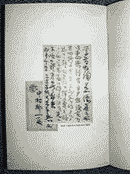 |
Letter of General
Nogi
Self-immolation of General Nogi for Emperor Meiji was a kind of the Hagakure concept. |
|
|
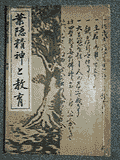 |
Hagakure spirit
and education
A commentary book on Hagakure, published during the World War II. Hagakure and the
Confucian chivalry are mixed and confused. |
|
|
 |
Portrait of
Mishima Yukio
He, undoubtedly first-rate as a novelist, was also unaware of the difference between the
two types of chivalry. |
|
|
The significance an dinstruction of Hagakure in the present days
On the whole, it can be said that the bureaucratic or nomocratic nation since the Edo
shogunate had, until recently, a backbone or axis of a tycoon or emperor, and that the
bureaucrats, excellent and with profound sense of responsibility, constructed the current
Japan. However, seeing that the axis has gone away and that we have to indicate the loss
of the bureaucrats' perspective responsibility, we rather must go back to the days of
chivalry in the Middle Age, recovering responsibility ourselves as citizens.
This should be a true "democracy." Thinking chivalry leads directly to democracy
in the end. We should not forget the fact that in the former times Japan had a tradition
of democracy, too. |
|
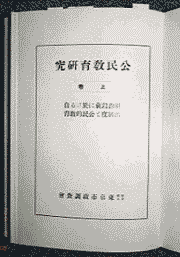 |
Komin Kenkyu
(study on citizenship education)
A book written, despite under the old pre-war constitution, to elevate the maturity of the
Japanese people's understanding to democracy. It should be said that this book
demonstrates the necessity of studying the traditional Japanese chivalry. |
|
|
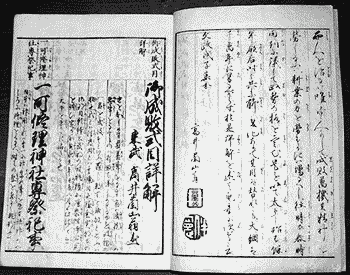 |
Goseibai Shikimoku
and Osadame Gaki
These two codes are, in the essence, the same "samurai's law." The former was
enacted in the 13th Century, and the latter in the 18th Century. The important point is
that, rather than the difference of the period of the formation, the former is a kind of
unwritten law, like Anglo-American law, and the latter is something like a set of minute
notices. |
|
| Goseibai Shikimoku |
|
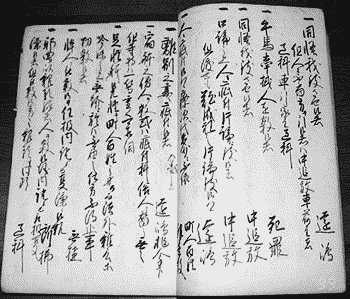 |
| Osadame Gaki |
|
| Finally, I believe that we Japanese should study the former, namely Goseibai
Shikimoku, more than ever. |
|
[ HOME | BACK(7-8) ] |
![]()
